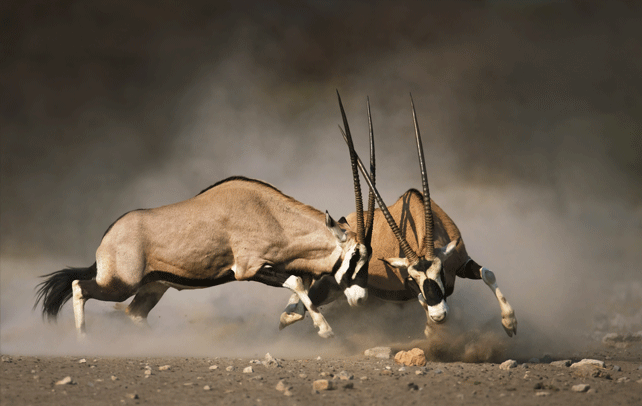Fun Facts About Oryx

The graceful oryx belongs to the category of being one of the rarest mammals on earth. This animal is so much adapted to the parched and brutally hot landscape that its ability to go on without water for a prolong period can only be rivalled by that of the camel. Oryx is among the four antelope species of the genus oryx. Out of the four oryx species, three can be found in the arid tracts of Africa and the fourth specie is native to the Arabian Peninsula. Oryx has wonderful long spiky horns with a neck and mane resembling that of a horse. They have very supple muscular body structure with distinct black outlines against the white face. Their long horns are almost straight except that of the Scimitar Oryx, who has curved ones and lack the typical dark markings on the legs while the Arabian Oryx has light marks on the head. During the ritualistic display of dominance, these antelopes show their distinctive features to exhibit their long ringed horns that can reach upto 1500 mm in length. Read the next section to know more about oryx.
Fast Facts
Binomial Name: Oryx gazella
Kingdom: Animalia
Phylum: Chordata
Class: Mammalia
Order: Artiodactyla
Family: Bovidae
Subfamily: Hippotraginae
Genus: Oryx
Species: 4
Weight: 250 to 390 pounds
Length: Body: 1530 to 2350 mm and Tail: 450 to 900 mm
Life Span: Up to 20 years
Diet: Herbivorous/grazer
Habitat: Dry plains
Gestation Period: 8½ months
Number of Offspring: 1
Interesting And Fun Facts About Oryx
- The name oryx was derived from a greek word Ὂρυξ (Óryx).
- Oryx is sometimes considered as the specie of wild buffalo, the giant auroch that became extinct during the Mesopotamia civilization.
- Oryxes were originally found in Iraq, Syria, Jordan, Israel, the Arabian Peninsula, and Sinai.
- The habitat of an oryx consists of deserts, arid plains, thick bushes, and rocky hillsides.
- Arabian Oryx (Oryx leucoryx), Scimitar Oryx (Oryx dammah), Eastern African Oryx (Oryx beisa), and Gemsbok (Oryx gazelle) are the four species of Oryx.
- Among the four species of oryx, Arabian Oryx is the smallest one.
- The last wild Arabian Oryx was wiped out in 1972 by a hunter.
- The Arabian Oryx was saved from extinction through captive breeding program and reintroduced to the wild. Arabian oryx was the only species that was downgraded from the status of extinct to vulnerable.
- According to the 2011 stats, the number of oryx in the wild is 1000 while in captivity it ranges between 6000 and 7000.
- Arabian Oryx, though not very good as speedster, can walk large trails. They have been known to walk for about 70 km in night!
- The Scimitar Oryx that were once declared extinct, survive under captive breeding program today. The Tunisia reserve is being expanded to introduce them to the wild.
- The east African Oryx that inhabits in eastern Africa is now placed under the category of near threatened by the IUCN.
- East African Oryx proper (oryx beisa beisa) and the Fringe-eared Oryx (oryx beisa callotis) are the sub-species of East African Oryx, which were related to gemsbok (a large antelope of the Oryx genus) in the past.
- 93 gemsboks were released at the White Sands Missile Range, New Mexico between1969-1977. Subsequently, the population of these non-indigenous species increased and now there are more than 3000 gemsboks in that region.
- A large population of gemsboks in the White Sands Missile range are now becoming the reason of damage to the nearby White Sands National Monument.
- Inhabiting in the southern part of Africa, gemsbok, has derived its name from the Dutch name of male chamois because both share the same characteristics.
- Adult males fight with each other in order to establish their hierarchy. Although the fight might look like a game but it plays a very important part to determine the dominant male among the herd.
- The female oryx can produce one calf per year, in favourable conditions.
- Both male and female oryxes possess horns that range from 600 to 1500 mm in length.
- Female oryx has thinner and longer horns as compared to the male oryx.
- New born oryx can run along its mother as soon as they are born.
- Oryxes don’t prefer to wander in their habitats; instead they like to dig shallow depressions in ground surrounded with bushes and shrubs for sleeping or resting.
- They have a very receptive nose that can even sense rain. They follow the rare rainfall to feed on newly grown grasses.
- Because of their gregarious nature, oryx usually live in big herds that can have as many as 100 of them.
- Although oryx is known to live in a large herd but it also gives priority to personal attention.
- Scimitar Oryx are very adaptable in regulating body temperature according to their water needs. They can raise their body temperature to a mark of 116 degree Fahrenheit to prevent sweating.
- Since the skin of Arabian Oryx lacks glare and reflection, it is very difficult to spot them even at a distance of 100 meters. They seem almost invisible.
- The oryxes have been known to kill even lions with their lethal long horn. Because of this feature, they are known as ‘saber antelope’.
- Oryx can survive in very inhospitable climate with sparse availability of food.
- Just like other antelopes, Oryx also depend on long jumps to escape themselves from predators.
- Oryxes are known to survive without water for a long time. They usually derive water from wild melons and leaves that they eat.
- All the African species of oryxes are large, fast, and powerful.
- The Hebrew word re’em, which mean ‘wild ox’ in the new American standard bible is referred to Arabian Oryx and unicorn.









